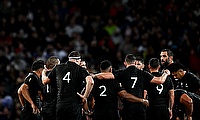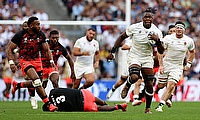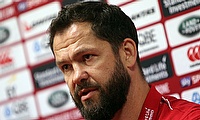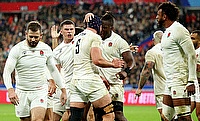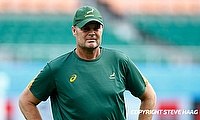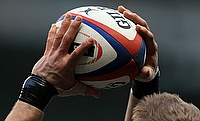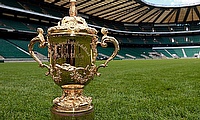World Cup provides rite of passage for Carter and Wilkinson
For many, the fly-half position is the most talked about in professional rugby. With so many differing attributes making up the number ten jersey though, it is hard to create an ideal blueprint for the perfect ten.
That is why arguably two of the best fly-halves in the world ever, have so very different qualities.
Jonny Wilkinson and Daniel Carter have been at the top of their games for years, picking teams apart with a mixture of devastating running and metronomic kicking accuracy.
Both men started out their careers at inside centre, before making the switch to outside half.
Both men have also been voted IRB player of the year, Wilkinson in 2003 and Carter 2005, while both have over 1000 points for their respective country and currently populate the top two leading points scorers in test match history.
The biggest difference between the two is the way the points were scored.
Of Wilkinson's 1,198 points for England, 30 of them have come from his six tries for his country.
Carter has crossed for New Zealand 29 times, nearly five times more than Wilkinson, making a total of 145 from his 1088 career points coming in the way of tries.
This goes some way to showing the stark difference between the men.
Carter has made a career out of playing a free-flowing attacking game, looking as dangerous with ball in hand as off the boot.
Meanwhile Wilkinson has been throughout his careers, one of the best defensive tacklers in the game.
For all Carter's try scoring ability, his position in the midfield has always been a target for opposition players as a channel to exploit.
Like many of the great fly halves, Ronan O'Gara another example, Carter's assets are while on the front foot, while perhaps showing a weakness on the defensive side of the ball, unlike Wilkinson, who was as lethal with ball in hand as was without.
In his pomp, Wilkinson could be seen tackling men far bigger than his modest frame of just under 5ft 10.
It may well be though that his greatest quality, has also been his biggest downfall.
Wilkinson, unlike Carter, has a well-publicised history of injuries, perhaps caused by his ability, and in some cases obligation to defend his team's cause.
The well documented knee, back and shoulder problems, the latter of which, he allegedly played with during the 2003 semi-final and final at the World Cup.
It is credit to the Ex-Newcastle star's determination that a career that began 1998 and has been so plagued by injuries, is carrying on, though some say barely, into it's 14th year and fourth World Cup.
It is of course 2003, Wilkinson's second tournament, Carter's first, that changed both their careers positively, but in very different ways.
Carter, then 21, was just starting out in a team that just like today, possesses a rich vein of talent, tough for any young player to cut their teeth in.
Playing at 12, Carter was in good company, with Tana Umaga, Leon MacDonald and of course his predecessor to the number ten jersey, Carlos Spencer surrounding him - all greats of the game, with many lessons to be taught.
Carter was to start every one of the All Blacks' pool matches, scoring tries against Italy and Tonga, on his way to a total haul of 40 points.
Despite playing no further part in the latter stages of the tournament, which ended in disappointment for his side, getting knocked out in the semi-final against Australia, Carter gave a good account of himself, and left the New Zealand faithful in no doubt that the fly half position was in safe hands.
The England fans weren't even asking the question about Wilkinson.
The Surrey born playmaker, 24 at the time, was at the height of his powers, fresh from guiding England through a Grand Slam six nation victory, which followed a successful Autumn series, with consecutive wins over Australia, South Africa and a Carter-less
New Zealand.
Having topped their pool with wins over Georgia, the Springboks, Samoa and Uruguay, the last of which 'Wilko' was rested for, England overcame Wales in the quarters before facing Les Blues, fresh from their demolition of the Irish.
This was the first time Wilkinson really came to the fore in the tournament, scoring all 24 of his side's points, including drop goals off both feet, providing a preview of what was to become the most watched moment in English rugby history.
The final three points in that tournament, will of course be the most remembered, but many forget Wilkinson scored 115 other points in that competition, despite being rested and injured for much of the latter stages.
It is apt then, that the careers of two of the greatest the game has ever seen, will intertwine on the biggest stage of all for one last time.
Like in 2003, one of them is coming to a landmark point in their respective careers, but where Carter's was beginning, Wilkinson is having his swansong.
Another similarity to eight years ago is of course that one of the men, this time Carter, will enter a world cup as the best player in the world in his position, and will also be in a situation where a winners medal at the tournament, is not just predicted, but expected.
Such is the dominance the All Blacks have possessed over the past four three years at least, that a second world cup win would be the least surprising result on the sporting calendar.
That being said, their propensity to underperform in the tournament since they won the inaugural event in 1987, has lengthened their odds somewhat, but with Carter at his best, alongside an impressive cast, they must still be favourites.
Whatever happens in the tournament, Carter's and Wilkinson's respective positions in rugby folklore.
That being said, both men have the opportunity to impact their team's quest for a second title, with Carter taking the lead part in the All Blacks production, while Wilkinson moves into the role of best supporting actor role, played so brilliantly by Mike Catt in 2003.
Either way, the next chapter in the changing of the guard, is guaranteed to be an intriguing one.


